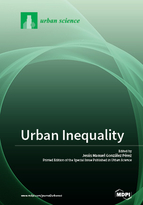Urban Inequality
A special issue of Urban Science (ISSN 2413-8851).
Deadline for manuscript submissions: closed (28 February 2018) | Viewed by 50526
Special Issue Editor
Interests: urban studies; urban planning; spatial planning; tourism; Europe; Caribbean; Latin America
Special Issues, Collections and Topics in MDPI journals
Special Issue Information
Dear Colleagues,
The city product of the crisis of 1973 is urbanistically extensive and socially unequal. One of the main problems of the recent process of urbanization is the increase of the polarization and the social inequalities in the inner city. About ten years ago, Michael Pacione (2005) characterized the postindustrial city by the coexistence of four main processes. One of them is the increase of the inequalities, the social and spatial segregation, the privatization of the urban space and increase of the defensible spaces. From an urbanistic point of view, the fragmentation of the urban form is a consequence of many of these processes and an increasingly palpable reality of the city of the 21st century.
The analysis of urban inequalities needs new analyzes and interpretations in recent years. The socio-urban consequences of the economic crisis and policies called post-crisis (or austerity) are transforming everyday life in cities around the world, with a special focus on countries of the Southern Europe. There are processes of impoverishment, increased vulnerability and social segregation, which is producing a new space order. The first public responses to the crisis were dominated by the impulse of neoliberal policies, which are aggravating socio-urban inequalities.
In this context, the objective of this Special Issue is to study inequalities in the city at different scales and in all territories, from informal settlements and the “urbanization of poverty” in the countries of the South to the fragmentation of the city, urban segregation or gentrification as global phenomena in the city of the 21st century.
Prof. Dr. Jesús M. González Pérez
Guest Editor
Manuscript Submission Information
Manuscripts should be submitted online at www.mdpi.com by registering and logging in to this website. Once you are registered, click here to go to the submission form. Manuscripts can be submitted until the deadline. All submissions that pass pre-check are peer-reviewed. Accepted papers will be published continuously in the journal (as soon as accepted) and will be listed together on the special issue website. Research articles, review articles as well as short communications are invited. For planned papers, a title and short abstract (about 100 words) can be sent to the Editorial Office for announcement on this website.
Submitted manuscripts should not have been published previously, nor be under consideration for publication elsewhere (except conference proceedings papers). All manuscripts are thoroughly refereed through a single-blind peer-review process. A guide for authors and other relevant information for submission of manuscripts is available on the Instructions for Authors page. Urban Science is an international peer-reviewed open access quarterly journal published by MDPI.
Please visit the Instructions for Authors page before submitting a manuscript. The Article Processing Charge (APC) for publication in this open access journal is 1600 CHF (Swiss Francs). Submitted papers should be well formatted and use good English. Authors may use MDPI's English editing service prior to publication or during author revisions.
Keywords
- urban segregation;
- gentrification;
- urban fragmentation;
- social polarization;
- social vulnerability;
- social exclusion;
- gated communities;
- evictions;
- informal settlements






